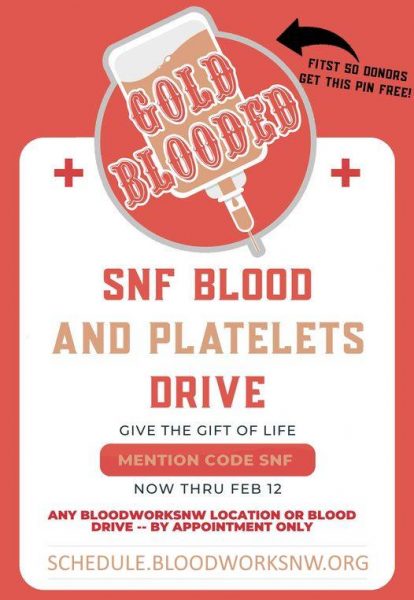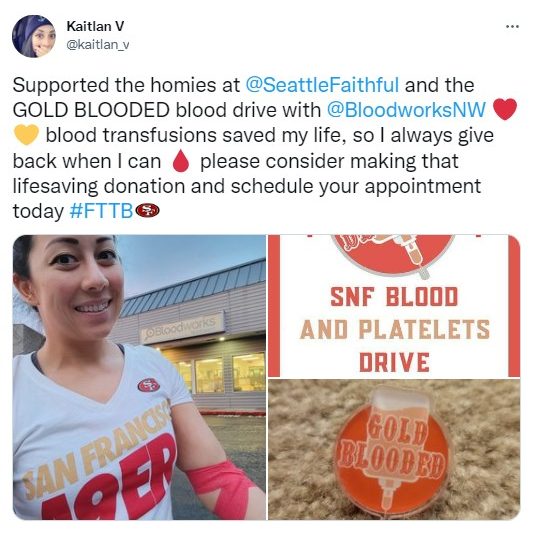Bloodworks donors always inspire me. Conversations with donors lift my spirits and encourage me to schedule my next blood donation. If I’m having a bad day, I can visit Bloodworks’ social media pages to see positive comments or search the #BloodworksNW hashtag for photos of people selflessly giving of themselves to a stranger.
When I saw a pic on Bloodworks’ Instagram account of a donor repping the jersey of my favorite player on my favorite football team, I got an idea: why not see if other local fans would be interested in donating?
Now, I just want to be transparent: I have a lot of love for Riq and his crew, but this team not the Seahawks.

I’m a member of a local group that gets together each week throughout the NFL season to watch games in cities that just so happen to correspond with Bloodworks donor centers: Seattle, Everett, Federal Way, and Silverdale.
As a Seahawks division rival, our team doesn’t get a lot of love in Washington and Oregon, so it’s nice to have a space to cheer with others.
Though we follow a team based out of another state, we’re still very rooted in the local community: this group gives back to kids in the greater Seattle area by hosting a toy drive each holiday season and raised nearly $2,000 to buy shoes for a local school over the summer.
These are people who would figuratively bleed for their team, and I guessed they would literally bleed for them as well.
I floated the idea of a virtual blood drive, which allows people anywhere from Bellingham, WA to Eugene, OR to donate at a convenient donor center or mobile drive and it counts towards a total. The group president messaged me immediately with his support, and the response from members on my Facebook post was overwhelmingly positive:
It was motivating to see how many people I had never met knew about the need for blood and were already blood donors. I even connected with a former Bloodworks coworker, who I didn’t realize was in the group!
So now we had to get to work.
For a successful blood drive, “A timeframe, goal, and commitment for the group main point of contact are key,” said Meg Hall, Director of Community Engagement and Expansion.
Bloodworks has a team of Community Engagement Liaisons (CELs) who work with donor groups to schedule blood drives. Each CEL covers a specific territory and are assigned to donor groups based on location.
I worked with Sasha Seiden, manager of Community Engagement, to set up a virtual blood drive.
Now that more companies and organizations operate remotely, a virtual drive is a neat alternative to the traditional on-site blood drive.
Virtual drives work well for groups that are geographically spread out but still want to donate as a group. Donors can select a Bloodworks center or blood drive that is most convenient for them.
Bloodworks sets up a unique 3- or 4-digit code for each virtual drive — donors give this code at registration or mention the donor group so that their donation counts towards the drive total.
And as someone who prefers to give platelets, I love it: I can give platelets at my preferred donor center, and it counts!
The code we wanted was available, so Sasha set it up and told me it would be available as soon as the following day.
While a traditional blood drive typically lasts a day or two, virtual drives usually run 2, 4, or 8 weeks, depending on the needs of the group.
“We usually recommend a 2-week period just to give a more specific timeline for a call to action but can be flexible,” said Sasha.
We wanted to get the drive up and running relatively quickly to meet the present need for blood, though a longer drive would give enough time for any regular whole blood donors in the group to be eligible to participate.
We decided to go for six weeks, which coincided with the end of the football season.
And we would push anyone who was ineligible to donate whole blood in that period to try platelets — after all, our team colors are red (whole blood) and gold (platelets)!
“We find setting a goal can help keep groups motivated,” Sasha told me.
With a group of our size (several thousand members in Western Washington), 49 donors felt like a reasonable and realistic goal.
Setting up the drive was super easy. But would people show up?
When I worked for a large tech company, Bloodworks would be on site every 56 days or so. There would be emails from facilities, posters around the building, and table tents in the kitchens leading up to the drive. The day of the drive, you’d pass A-frame signs pointing you to the location and could even peak into the room through an open conference room door on your way to lunch. I’d ask my coworkers in-person to join me while seated at our desks.
A virtual drive relies so much more on digital communication and word of mouth to get people to make and keep their appointments; I’ve been asking strangers to donate blood for years and still felt overwhelmed by this task.
Sasha let me know that she had templates for each possible method: email, social media, print, etc.
A list of Virtual Drive Best Practices and Frequently Asked Questions gave us a good idea of where to start and helped us develop a timeline for promoting the drive, as well as templates for digital flyers and social media copy and graphics.
Alex, the group’s president, is a great graphic designer, so created custom graphics that matched the spirit of the drive.

Alex also ordered special pins for the first 50 donors and shared a picture in a post on Facebook. He responded to everyone’s individual comments, walked them through how and where to schedule their donations, and repped the drive at in-person game viewings.
We also pushed people to give together at our Federal Way donor center.
“Someone said ‘If only there was one close to me,’ to which I said, ‘good thing there’s one in literally the same parking lot we watch games at,’” Alex shared. “He and his daughter signed up right away.”
While Bloodworks does offer official donor center takeovers, where a group commits to filling all selected appointments at a donor center or Pop-Up during a given timeframe, we decided just to encourage donors to fill open slots in Federal Way on game days.
The number one reason people don’t give blood is because no one ever asked them. A Facebook post or an email isn’t always enough: you need to have those one-on-one conversations with people and make them understand how easy and important it is to save lives.
And sometimes, it’s just the right person asking for the right reason. People are passionate about sports. One first-time donor reached out to me to let me know that he was nervous and asked for tips. As it turned out, his wife and son were regular, dedicated donors, but it took his favorite football team and someone who worked at Bloodworks to help him conquer his fear of needles.
Other group members shared that they had received blood — even with 1 in 4 people needing a blood transfusion at some point in their life, it still surprises me how many people I know have depended on donated blood.

We also got to educate people through this drive. Blood donation eligibility changes all the time. In fact, halfway through our drive, the “mad cow” deferral lifted, and we got to help some people schedule their first-ever blood donations.
We came in a few donors shy of our goal, but I was truly in awe of this opportunity and grateful to Alex and all of the donors for taking on the challenge!
And we can’t wait for Superbowl LVIII.
Tell Us What You Think!